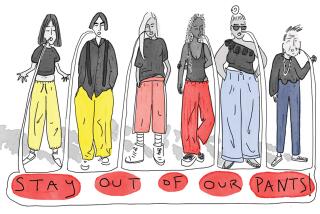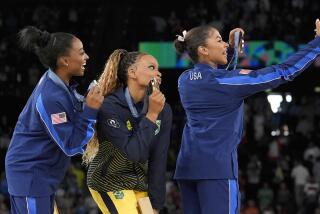Sports Bras Are a Bust for Some
- Share via
Two women runners created the first one in 1977 by sewing together two jockstraps. One woman soccer player focused worldwide attention on the newest one by showing off her buff cups at the 1999 World Cup. In just over two decades, the sports bra has come a long way.
Not since 19th century feminist Amelia Jenks Bloomer designed baggy trousers to give women the freedom to participate in athletics has a piece of apparel so changed the shape of female fitness. Before the creation of the mother of all sports bras, the Jogbra, breast discomfort and embarrassment kept many women from participating in high-impact sports.
Today women run, climb, skate, play basketball and virtually every other sport, supported by the booming, $300-million-a-year sports bra industry, which has followed--or perhaps led--this explosive growth in women’s athletics. Yet despite the dazzling variety of colors and styles now available, most sports bras are still a bust for the typical American woman, who wears a size 36C.
“Almost universally, sports bras have not satisfied women who wear a C-cup or larger,” says Judy Mahle Lutter, president of the Melpomene Institute, a Minnesota-based research organization devoted to women’s health and physical activity. “Larger-breasted women, and women who are breast-feeding, often have trouble finding a sports bra that fits, feels comfortable and provides sufficient motion control.”
Inability to find a satisfactory sports bra keeps many women from exercising, says Lutter, whose organization recently ran a sports bra survey in its newsletter. “Some women report wearing two or three bras at one time” to get sufficient control, she says. Others bind their breasts with Ace bandages to minimize “jiggle” and wear T-shirts under their bras to eliminate chafing.
A woman who had breast reduction surgery said one of the biggest benefits was being able to exercise and swim without attracting stares. A study conducted last year by the American Council on Exercise reported that “a large majority of women experience breast discomfort while exercising” and either suffer in silence or avoid physical activity altogether.
When ACE commissioned a team of researchers from the University of Wisconsin-La Crosse to evaluate five of the most popular sports bras designed for large-breasted women (size C-cup or larger) they found that some provided no more support than regular bras.
Part of the problem is that “the average bra size has increased from 34B just 20 years ago to 36C (plastic surgery and the use of birth control pills have been implicated),” notes an article about the ACE study, published in the organization’s journal, FitnessMatters.
Smaller-breasted women, who wear an A- or B-cup, typically fit well into compression bras, which press the breasts against the body. Their major dissatisfaction is the unflattering look.
*
Larger-breasted women, however, generally can’t wear compression bras and need the support found in another style of sports bra, which encapsulates each breast in a harness-like device. “Coverage is typically greater (in encapsulation bras), and straps and clasps of all sorts help to keep the breast in place,” the journal notes. But while there are “countless styles and fabrics to choose from” in compression bras, encapsulation models tend to come in fewer varieties and carry higher prices.
Indeed, the attention-grabbing sports bra worn by U.S. World Cup soccer heroine Brandi Chastain is available only in A- and B-cups, notes Nike spokeswoman Kathryn Reith, who is quick to add that the company’s new Inner Actives line also includes styles for fuller-busted women.
The highest-rated bra in the ACE survey was the Champion Action Shape Sports Top, one of more than 50 styles of sports bras made by Champion Jogbra, which is now owned by the Chicago-based Sara Lee Corp.
*
A good sports bra is much more than a fashion statement. It’s an essential piece of sports equipment. “If you ask women who work out what their most important piece of equipment is, shoes and sports bras tie for first,” says Missy Park, the self-described “chief bra guru” at Title Nine Sports, a California mail-order company specializing in women’s sports apparel. “But the surprising thing is that many women don’t know their proper bra size.”
Bra size often changes, after pregnancy for example, or as a result of weight gain or medication. “Yet many women never remeasure themselves,” notes Park, who says her company’s sales associates are trained to talk women through the measurement process. (Call [800] 342-4448.)
To select a sports bra that’s right for you, ACE experts advise:
* Choosing a bra that has good ventilation so sweat won’t be trapped, increasing friction and chafing.
* Making sure the clasps or straps don’t dig into your skin. A good sports bra should fit comfortably from the very first wearing.
* Mimicking the exercise you’ll be doing when you’re trying on a bra. You might want a different type of bra for lower-impact sports than you would for aerobics or jogging.
* Keeping in mind that sports bras lose elasticity over time and should be replaced every six months to a year.
Carol Krucoff writes a column on health and fitness issues for the Washington Post.
More to Read
Go beyond the scoreboard
Get the latest on L.A.'s teams in the daily Sports Report newsletter.
You may occasionally receive promotional content from the Los Angeles Times.










